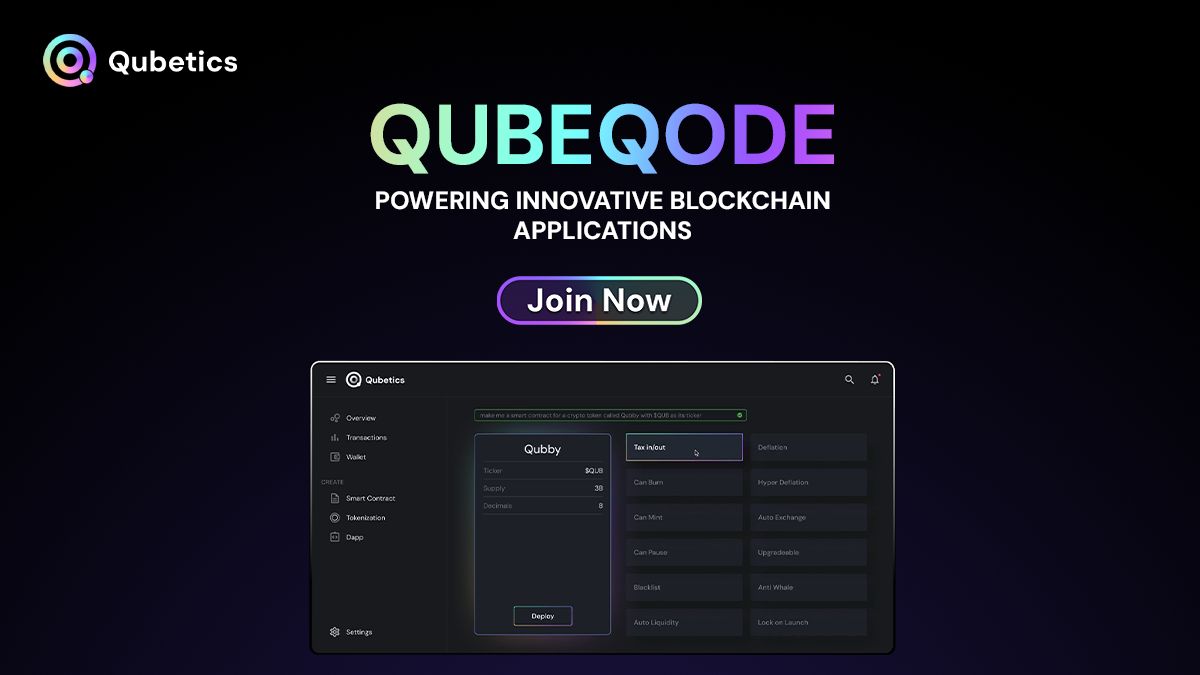Why is blockchain development still challenging for many businesses and developers? Despite the rise of decentralised applications, coding for blockchain remains a complex process that deters wider adoption. Qubetics is addressing this issue with its innovative QubeQode IDE, offering a more accessible approach to blockchain development.
Alongside established projects like Ethereum, Monero, Stellar, and BNB, Qubetics is poised to significantly impact. In this article, we explore the recent trends of these four coins and why Qubetics’ presale, with its potential for massive returns, creates a strong sense of urgency for investors.
Qubetics: Streamlining Blockchain Development with QubeQode IDE
Qubetics is set to revolutionise blockchain development with its QubeQode IDE, a platform that simplifies the creation of decentralised applications (dApps) and smart contracts. By offering a drag-and-drop interface powered by AI, QubeQode makes blockchain development more accessible to seasoned developers and those new to the space. This solves a real-world problem by lowering the technical barriers often associated with creating dApps, allowing businesses to adopt blockchain technology faster and more efficiently.
In addition to its development tools, Qubetics has gained significant traction with its ongoing presale. Currently in its fifth stage, the $TICS token is priced at $0.015, with the presale already raising over $1.35 million. The potential returns are extraordinary—if $TICS reaches the forecasted post-launch price of $15, early investors could see a 93,800% ROI. A modest $100 investment would yield approximately 6,666 $TICS tokens, which could grow to an impressive $99,990 if the token hits its target. With such high potential gains, the Qubetics presale is a rare opportunity for those looking to invest early.
Ethereum: The Backbone of Decentralised Applications
Ethereum remains the dominant force in blockchain development. It is known for its smart contract capabilities and as the foundation for most decentralised applications. The Ethereum network supports a vast ecosystem of DeFi projects, NFTs, and other blockchain-based innovations. In recent developments, Ethereum’s ongoing shift to Ethereum 2.0 has taken centre stage. This transition to a proof-of-stake model is expected to drastically reduce energy consumption, improve scalability, and reduce transaction fees. These improvements are essential to Ethereum’s leadership position as developers increasingly seek faster, more efficient platforms to build on. While Ethereum remains a solid choice for blockchain projects, its high transaction costs and congestion still pose challenges, which solutions like Qubetics’ QubeQode IDE aim to resolve.
Monero: Prioritising Privacy in Cryptocurrency
Monero (XMR) has consistently stood out for its focus on privacy and security. Unlike most cryptocurrencies, which leave transaction data visible on the blockchain, Monero uses advanced cryptographic techniques to ensure that transaction details—including sender, receiver, and amount—are private. Recent trends show that Monero’s emphasis on privacy resonates, particularly as governments and regulatory bodies push for more transparency in the crypto space. Monero’s unique privacy features make it a preferred choice for users who prioritise confidentiality in their transactions. Monero’s utility and adoption are expected to increase as global demand for privacy grows.
Stellar: Revolutionising Cross-Border Payments
Stellar (XLM) focuses on simplifying cross-border payments and providing fast and low-cost transactions between currencies. Stellar’s blockchain allows financial institutions and payment providers to transfer funds in a fraction of the time it would take with traditional banking systems and at significantly lower costs. In recent developments, Stellar has strengthened its partnerships with global financial institutions, furthering its mission to promote financial inclusion, particularly in underserved regions. As more companies and institutions adopt Stellar’s technology for remittances and international payments, its relevance and importance in the blockchain space will likely grow. For investors interested in global payments, Stellar presents a compelling opportunity.
BNB: Powering the Binance Ecosystem
BNB is the native token of Binance, the world’s largest cryptocurrency exchange by trading volume. Initially created as a utility token to reduce transaction fees on Binance, BNB has evolved into a critical component of the Binance ecosystem, which includes Binance Smart Chain (BSC), a platform for DeFi and dApps. Recent trends show BNB’s growing influence in the DeFi space, with many projects choosing to build on BSC due to its low fees and fast transaction speeds compared to Ethereum. BNB’s integration into a wide range of Binance services, including staking, payments, and more, boosts its demand, making it a popular choice among crypto investors.
Conclusion
As blockchain technology evolves, Qubetics, Ethereum, Monero, Stellar, and BNB each offer unique solutions to the industry’s challenges. Qubetics, with its QubeQode IDE, simplifies blockchain development and removes the barriers preventing wider adoption. At the same time, its presale offers investors the potential for massive returns—a rare opportunity to be part of a project with such significant upside. Ethereum remains the leader in dApp development, while Monero offers unmatched privacy, Stellar streamlines cross-border payments, and BNB powers the expansive Binance ecosystem. For investors looking to capitalise on high-potential projects, Qubetics’ presale stands out as one of the most compelling opportunities. If its ambitious price targets are met, a $100 investment could turn into $99,990. With limited time left in the presale, the time to act is now.
For More Information:
- Qubetics: https://www.qubetics.com/
- Telegram: https://t.me/qubetics
- Twitter: https://twitter.com/qubetics
Disclosure: This is a sponsored press release. Please do your research before buying any cryptocurrency or investing in any projects. Read the full disclosure here.



